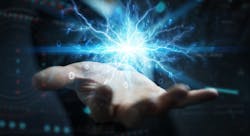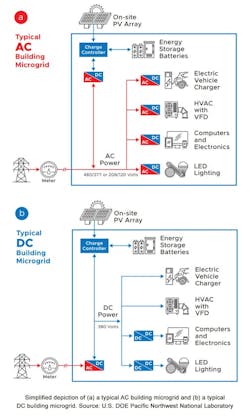By Betsy Conroy
A recent report from Guidehouse Insights states that the global market for Power over Ethernet (PoE) is anticipated to grow from $113.8 million in 2021 to $614.9 million by the end of 2030. The growth of PoE is being driven in part by the rise in smart building development and will be further fueled by a variety of emerging digital power technologies.
According to Young Hoon Kim, senior research analyst with Guidehouse Insights, “PoE is expected to be a key connectivity solution in building network infrastructure. Many building network renovations and new building construction projects are expected to adopt the technology due to its core benefits of reliability, flexibility, and easy installation.”
While PoE has long been touted for its easy installation and reduced labor costs, eliminating the need to run traditional AC electrical wiring to power connected smart building devices, industry experts say cost is no longer the driving factor. According to Luis Suau, chief business officer with Sinclair Digital, LLC, it’s now more about the improved efficiency, sustainability, and safety achieved by replacing AC power with DC power throughout the building.
“From a construction standpoint, digital power requires less material and less labor to install, which is critical at a time where everybody is suffering with increasing material and labor costs and shortages. But cost is not the only driving factor anymore,” says Suau. “Digital power uses less copper, and copper is a limited resource—we can’t mine it forever. There’s also significant loss in efficiency and heat generation that happens when you convert AC to DC to power things like LED lights and IT equipment.”
And Suau knows firsthand how a DC-powered building can save on energy. CEO of Sinclair Digital, Farukh Aslam, started the company as the developer of the Sinclair Hotel in Fort Worth, Texas, the world’s first all-digital hotel that uses VoltServer’s Digital Electricity and PoE to power everything from lighting and window treatments to minibars and smart bathroom mirrors.
The company has since grown and is now consulting in the development and transformation of digitally powered, net-zero buildings across the country like the former Pirelli office building in downtown New Haven, Connecticut that will provide all of its own electricity, heat, and hot water.
“We started with PoE, but the idea is to take over the entire building microgrid and traditional AC infrastructure to eliminate conversion,” says Suau. “By shifting to a fully DC building microgrid, we can directly couple solar and achieve net-zero.”
Are DC microgrids the way of the future?
As discussed in the white paper “DC Lighting and Building Microgrids” from the U.S. Department of Energy’s (DOE) Pacific Northwest National Laboratory, DC building microgrids that draw from on-site solar and energy storage can allow entire buildings to disconnect from the traditional power grid during outages.
While the goal is to permanently disconnect and achieve net-zero, authors Arnold and Pennel point out that moving to fully DC-powered buildings, “requires changes to equipment, devices, wiring methods, installation, practices, codes, and standards.” They recommend incentives, regulations, and support from lighting, HVAC, and other device and equipment manufacturers to help pave the way. Since the publication of that paper in 2020, Suau says that thankfully, the shift is starting to happen.
“While the Sinclair Hotel uses 39% less power, we didn’t do a complete DC microgrid at the time. However, laying out a strategy to move in this direction is now behind us—it’s already happening,” says Suau. “We’re seeing major acquisitions of DC systems and manufacturers of everything from IT equipment and HVAC compressors to refrigerators beta-testing their appliances to connect directly to the 380 V DC power building microgrid.” Suau likens the situation to that of the electric car and the fact that it took several years for every major car manufacturer to finally realize what Tesla did years ago.
Emerging digital power technologies
When it comes to delivering digital power throughout a smart building, Suau points to three main technologies of focus—PoE, USB-C, and digital electricity. PoE has already experienced significant advancements since it was introduced almost two decades ago, advancing from delivering 13 watts to IT networked devices to now delivering upwards of 75 watts. Single-pair Ethernet technology under development to support low-speed data connections over longer distances to OT networked devices, such as building automation sensors and controllers, will also deliver a form of PoE, or SPoE. Depending on the cable length, SPoE is targeted to support between 7 and 52 watts.
USB-C power delivery is a relatively recent technology introduced by the creators of the USB standard and supported by certain iOS and Android devices. USB-C power is coming off a powered device or via a wall charger/transformer for charging smartphones, tablets, digital cameras, and other consumer devices. With its ability to charge smartphones up to 70% faster than previous-generation USB technology, USB-C is rapidly gaining ground. While the first iteration of USB-C topped out at 100 watts, the USB Implementers Forum (USB-IF) recently announced that it’s working to more than double the amount of power to 240 watts, enough to power a high-end laptop.
“It’s becoming universal, and most laptops and smartphones are embracing it,” says Suau. “It extends DC power throughout a building by working in conjunction with PoE—we’ll now have devices that are powered by PoE in turn powering other devices by USB-C.”
Class 2 power, which includes but is not limited to PoE, delivers low-voltage DC power for applications including LED lights to thermostats. For powering connected devices in a smart building that are beyond the distance limitation of PoE or don’t have a copper network interface, Class 2 power can be delivered via copper conductors in hybrid fiber cable.
A new type of power getting attention is fault managed power, which is expected to be included in the next National Electric Code as Class 4. Fault managed power transforms AC or DC power into a pulse current waveform that is delivered over common multi-conductor power cables like those use in hybrid fiber cables. Each pulse has a short duration of time, and if the power is touched or shorted, it is automatically detected by a fault prevention system and stops transmission within milliseconds—far faster than a traditional AC circuit breaker for improved safety.
Fault managed power is expected to provide about 20 times the power over 20 times the distance of PoE, and it costs less than traditional AC due to smaller copper wires and the potential for installation by low-voltage contractors versus licensed electricians. “While Class 4 does communicate fault information, we don’t know yet if it will be expanded in the future to deliver more data. It an early technology,” says Suau.
Regulations, investment, and education will help
Suau admits that all these digital power technologies take time to come to fruition but recognizes that regulations will help.
“This is the future, and it’s just a matter of time before it catches on and regulations enforce it,” he says. “In Europe, there is already regulation happening to prevent banks from loaning money to developers that don’t have ESG goals, and we’ve got Local Law 97 in the City of New York.”
Local Law 97 is a New York City Building Emissions law that sets carbon emissions caps for energy use in city buildings greater than 25,000 square feet starting in 2024, with increasingly stringent limits by 2030. This groundbreaking climate legislations impacts more than 50,000 buildings that encompass nearly 60% of the city’s building area.
Investment and education will also be key to pushing forward with fully DC-powered smart buildings.
“Even those that have a stake in non-sustainable industries see digital power as a way to make money. And if there’s money to be made, they will embrace it—finance companies will finance construction if they see the benefit of tax incentives,” says Suau. “We also need more education and examples of buildings taking this approach—it’s not something you can just put on a slide deck and sell. The beauty of the Sinclair Hotel is that it’s a public space, and we give tours every week to show customers the possibilities.”
While there will be pushback from those rooted in the AC power world—from electricians to transformer manufacturers—Suau remains optimistic.
“The reality is that we’re moving to an IT world. The average age of a licensed electrician is 59.5 years, and the workforce is aging out. From a future workforce perspective, millennials don’t want to go into old technology—especially when there’s an alternative to making buildings safer and more efficient. But there is progress, and we’ve even had Local Union 3 ask us about training,” says Suau. “While there’s always the ‘innovator’s dilemma’ of sacrificing the old for the new, and everyone wants to keep their cheese, the fact is that we’re moving the cheese. All the winds are pushing us there and the opportunities are going to be huge.”
Betsy Conroy is a freelance writer, editor, and content consultant, specializing in business-to-business media and commerce. She has 30 years’ experience writing technical content.

